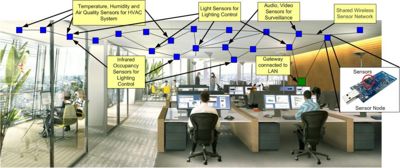Difference between revisions of "Building Automation"
| Line 13: | Line 13: | ||
<br style="clear:both;" /> | <br style="clear:both;" /> | ||
| − | We try to address some of these issues by exploring the feasibility of using WSNs for building automation. The use of wireless sensor networks for building automation enables '''high-density sensing''' and control at '''lower operational costs''' and could therefore enable more efficient building management. The figure | + | We try to address some of these issues by exploring the feasibility of using WSNs for building automation. The use of wireless sensor networks for building automation enables '''high-density sensing''' and control at '''lower operational costs''' and could therefore enable more efficient building management. The figure, above, shows an example of a WSN deployment for building automation. |
Revision as of 08:11, 29 April 2008
Building automation was identified, a few years ago, as an effective way of achieving (a) efficient long-term building management and (b) considerable reductions in building energy costs. Some already installed building automation systems (BAS) have successfully achieved between 20% to 80% reductions in energy cost, increased occupant security/safety, increased occupant comfort and a reduction in building operations cost. Although several BAS have been installed so far, they have not yet achieved significant market penetration nor have they been utilized to their full potential. This is due to the existence of several unresolved issues like:
- interoperability between individual sub-systems like HVAC control, lighting control etc.
- use of wireless sensors that facilitate reduced installation/wiring cost
- increased information sharing between the various sub-systems
- integration with installed IT enterprise networks
- better application modeling and deployment toolkits
- increased system reliability
- better algorithms and optimization techniques
- real time monitoring and analysis
We try to address some of these issues by exploring the feasibility of using WSNs for building automation. The use of wireless sensor networks for building automation enables high-density sensing and control at lower operational costs and could therefore enable more efficient building management. The figure, above, shows an example of a WSN deployment for building automation.
Contents
Sensors
Resources
- NIST Project, Development of testbed for wireless sensor network use in buildings
- DOE report, Advanced Sensors and Controls for Building Applications: Market Assessment and Potential R&D Pathways
- Sensor Networks for Building Automation: Energy Efficiency
- Interesting List of Data Sources
Companies
- Millennial Net
- Ember
- Gridlogic
- Siemens
- Honeywell
- Echelon
People
This work is being conducted by Sangeeta Bhattacharya, a current PhD student, under the guidance of Dr. Chenyang Lu and Dr. Gruia-Catalin Roman.
